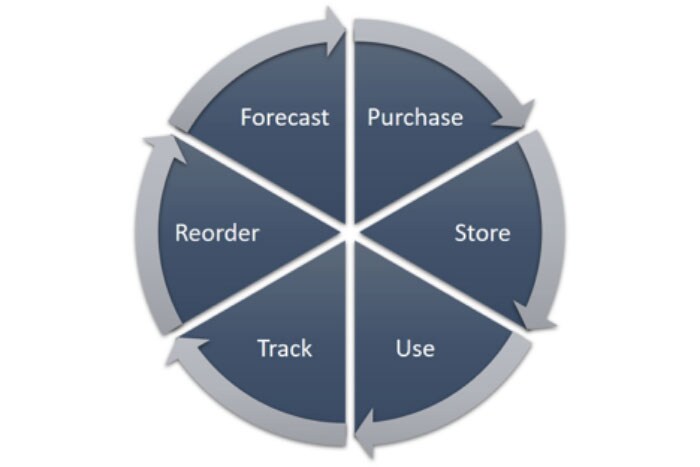Learn Inventory Planning Models, Benefits and How to Develop a Plan that Delivers More Efficiencies
This article covers the advantages of inventory planning and describes inventory basics, planning systems and planning software. Get expert tips from inventory consultants Patricia Johnson, Richard Outcalt and Darrel Whiteley.
In this article:
- Inventory planning basics
- Why you need to implement inventory planning
- How to develop an inventory plan
- Inventory planning systems
Basic Concepts in Inventory Planning
Inventory is stored materials that serve a current or impending need. Production and manufacturing organisations hold raw materials, finished items or works-in-progress to incorporate into new goods. Retailers stock finished or processed items to sell directly to customers.
Almost every organisation holds inventory. Even service organisations, such as hotels or software development companies, keep maintenance, repair and operations (MRO) stock to support the business. Examples of inventory for a non-production or non-retail company might include towels and soap, drain cleaner, light bulbs, garbage bags for cubicle bins, pens and timing belts for delivery trucks. Inventory is one of the largest assets on a company’s books.
Organisations hold inventory for several reasons. By keeping inventory, production or retail establishments can ensure they operate continuously and independently, with coverage for variations in consumer demand or stock delivery. In manufacturing, adequate inventory enables companies to be flexible in output scheduling. You can leverage bulk orders for discounts with planned inventory.
Inventory Process Flow
The steps of inventory process flow or the lifecycle of inventory apply to retail, manufacturing, maintenance and service organisations alike.
- Purchase:
Organisations buy inventory based on inventory planning research or, if the department or company is new, on their best estimate of what is needed. Although excess inventory is generally undesirable, organisations may overstock when making their first purchases. - Store:
Organisations must store or warehouse inventory in a clean, secure area, for which they will incur holding costs to cover lighting and heating or refrigeration. Organisations should devote time to researching and planning for convenient stock checking and retrieval from storage. - Use:
Organisations take stock items from inventory for their intended purpose as sales items, raw materials or repair parts. - Track:
Tracking stock as organisations retrieve or consume it is essential to maintaining production flow, cash flow and happy customers. Only by tracking what’s in stock can you know what and when to reorder. - Reorder:
You can reorder or replenish inventory automatically or manually. Mathematical, management and strategy models help you understand the optimal stock level to maintain, as well as the number of items to order and how often to order them. - Forecast:
Established enterprises and newer organisations that have experienced a few inventory cycles can anticipate, or forecast, inventory needs and timing. Forecasting helps to ensure you maintain optimal stock levels throughout the year.

Inventory Planning
Inventory planning helps companies buy the right amount of stock and decide how often to reorder. Inventory planning helps lower the costs of keeping items in stock and helps make sure there is enough stock for making and selling items.
Inventory planning is an essential part of supply chain management. Supply chain management ensures that raw materials, work-in-progress items and finished goods move efficiently from the source or factory to the consumer.
Essentials of Good Inventory Planning
Inventory planning directly impacts the cash flow and profits of any organisation. It prevents stockouts, so you can keep production running and save money on costly last-minute purchases, and it enables discounts for bulk and regular orders. Good inventory planning requires the right mix of people, process and technology.
- Inventory Planning Technology:
You can use software that initiates orders to ensure you top off stock to the appropriate level and prevent overstocking. Digital planning systems provide historical data for forecasting and a view into current inventory levels. The right software can help you scale your business. - Inventory Planning Roles and Responsibilities:
Inventory planners analyse trends and provide forecasts. Ideally, inventory planners work with supplier managers, purchasing and contract management leaders, supply chain financial analysts and production and quality control stakeholders. - Inventory Planning Policies, Processes and Procedures:
Inventory policies help you govern planning activities and step-by-step inventory maintenance processes. It is essential that you define and document your inventory planning processes and communicate your policies throughout the organisation and beyond, particularly to the supply chain. Your procedures can range from how you use enterprise resource planning (ERP) and other inventory software to how you store and pick items. Inventory procedures and checklists can help you guide warehouse and distribution centre staff in handling inventory.
Despite the advantages of inventory planning, many organisations don’t do it. When companies don’t plan, the inventory planner or consultant often comes in like a doctor during a health emergency to deal with excess inventory or shrinking profits.
Darrel Whiteley is a master black belt, lean master and Kaizen expert with Firefly Consulting. “Inventory shouldn’t just happen to you,” he states. “If you’ve gotten to the point where you want to plan your inventory, you know there’s certain variables you need to know. You need to know your lead times for your material suppliers. You need to know your online time for your manufacturing plant, and that needs to be a real time. Instead of assuming, use real data. Break down products by types. Don’t be afraid to stratify data and concentrate on those customers that pay your bills. Don’t worry about the customer who only calls up every three years.”
Objectives of Inventory Planning
The No. 1 aim of any business, besides making money, is customer satisfaction. In terms of inventory, if the right product in prime condition is not available at the right time, customer loyalty may suffer. Customer loyalty can affect profits because getting new customers is more costly than retaining customers, and loyal customers spend more as time goes on.
- Forecasting:
Also known as inventory estimation, forecasting is a systematic process of using a marketing plan to predict future sales and, thereby, future inventory requirements. A forecasting counterpart is inventory control, the process of counting and maintaining inventory items to understand usage patterns and uphold optimum inventory levels. - Controlling Costs:
Inventory costs, or holding and storage costs, can total 20-30% of your business costs. Holding costs can include the purchase cost for items, taxes, labour to receive and place inventory, insurance, security and even stock obsolescence, which is stock that is out of demand, old or in excess. The goal of inventory planning is to reduce all these costs. - Efficient Storage:
With well-designed storage facilities and by iterating the layout and design over time, you can favourably impact the bottom line. The ultimate use of inventory, whether in manufacturing, production or fulfillment, influences layout. The key point is to arrange high-demand items to reduce travel time. In this instance, high demand equates to frequently requested rather than high numbers of items. Learn more about designing storage facilities by reading “Warehouse Inventory Management Guide: Best Practices, Case Studies and Expert Advice.”
Challenges in Inventory Planning
Planning inventory and demand planning present multiple challenges, whether for retail or manufacturing. In addition to the difficulty of anticipating future requirements and sales, assorted barriers can hamper forecasting.
In retail, the very nature of the business sometimes obscures reasoned approaches to stock orders. Patricia Johnson and Richard Outcalt are cofounders of The Retail Owners Institute®.
“Retailers love to buy,” says Outcalt. “They love the new merchandise. Their staff is saying, ‘We should carry this or that.’ Everybody’s telling them, ‘Oh, we have to have more merchandise.’ Unless somebody at the top has the discipline to manage that targeted ending inventory and take markdowns quickly so that they’re sure to hit the target, they’re in trouble. The pressures to buy way outweigh the pressure to control. Somebody’s got to be tough.”
In production, Whiteley says manufacturers frequently treat every product line the same, even when only one line is seasonal. Manufacturers also produce excess inventory because they think it’s important to keep service levels consistent at all times.
“That may be true if you’re making heart valves for babies,” he says, “but not all products are critical. The most important thing to know about inventory planning is to understand the demands of the customer.”
Other factors can complicate the planning process itself:
- Disorganised Data:
You need historical inventory levels and sales information, but often this data resides in more than one system. You may have to look to accounting, fulfillment, logistics or point-of-sale (POS) systems to stitch together a complete picture. If you have other responsibilities, this could take time. - No Automation:
Software provides automatic tracking and reordering capability. Humans make mistakes, such as forgetting to make orders or miscounting stock. - Untrained Staff:
On the flip side, software is only as useful as the data users enter in. Staff requires proper training on any system for the best results. Poor master data management also restricts data’s usefulness and can result in problems such as miscalculated delivery lead times. - Perishable Inventory:
Perishable inventory includes items with an expiration date that deteriorate over time, such as food and cosmetics, and some service items, such as restaurant tables or concert tickets. Perishable stock requires a skillful effort to maintain service levels without ordering inventory that exceeds demand and then spoils or obsolesces. - Overreliance on Automation:
Technology alone cannot plan inventory. According to Outcalt, “there’s this illusion that computers and POS systems are supplanting sound inventory planning training or taking care of planning. POS systems, like accounting systems, are historians. They show to the penny what has happened already. But how do you project forward? What’s your profit plan for the year? What’s your buying plan for the year? For a lot of retailers, it’s like driving down the freeway at 65 miles an hour with the headlights out. Would you do that? No. But that’s how they’re driving their businesses, barreling along. They need the plan to be able to look ahead and see how to adjust.” - Multi-channel Warehousing:
Organisations frequently pull inventory from multiple locations, such as brick-and-mortar stores, distributions centres or warehouses. Tracking diverse sources adds complexity to both inventory management and order fulfillment. Fulfilling orders from diverse locations increases shipping costs, frustrating waiting customers. - Limited Cycle Counts:
With an annual cycle count, you reduce effectiveness because it usually means shutting operations for at least a day. You can take a more manageable and informative approach with frequent counts on select inventory. - Poor Picking Process:
With an inefficient arrangement of stock, you reduce productivity. Consider how far items must travel from inventory to the retail space or production floor. Place frequently requested items in areas for quick retrieval. - No Cross-Functional Communication:
In some organisations, R&D, procurement, production and quality control don’t talk about inventory requirements and potential issues until problems occur during production. - Planners Leave:
Frequently, inventory planners learn your brand and work through a few seasons to build knowledge of sales patterns, and then they move on. New inventory planners may struggle to understand the background and environment of the inventory without accurate historical data or sound systems to capture it.
What Inventory Planning Can’t Do
Although you should practice inventory planning, make sure to understand its limitations. For example, planning takes time and money, and you can waste both if you don’t implement the plan well or if you abandon them for discounts because the plan doesn’t seem to return profits fast enough. In addition, for the plan to work, staff must follow the processes. But there are no guarantees that trained staff won’t leave. And although a robust inventory system can surface and mitigate loss, it doesn’t stop people from stealing.
Advantages of Inventory Planning
Good inventory planning provides many advantages. At a high level, understanding what you have today aids with forecasting for the future.
According to Outcalt, “if owners don’t plan inventory ahead, they should get out of retailing. Not planning is a deal-breaker. And the most important number to focus on is their targeted ending inventory for each month of their plan.”
The sooner you plan for future inventory, the sooner you reap these benefits of planning:
- Reduce or eliminate stockouts.
- Reduce or eliminate overstocks, which drain profit margin.
- Optimise stock so you can easily spot slow-moving items you need to discount.
- Rotate stock to front displays to clear obsolete or perishable items.
- Increase cash flow through inventory flow. Inventory planning is crucial for smaller businesses, which rely on fast turnover.
- Increase profits with efficient production or robust sales. Outcalt explains, “In retail, the only way they make money is turning that inventory: bring it in, get rid of it, whether online or through bricks and mortar. Inventory is the money tied up on your balance sheet. And the more money tied up on the balance sheet, the less cash you have and the more debt you have. It’s simple: the lower the inventory, the better off you are. The higher the turns, the stronger the retailer. Selling inventory is the only way to make money.”
- Easily retrieve items from the warehouse or stockroom.
- Mitigate theft and abuse. Uncontrolled raw materials and goods can easily go missing.
- Eliminate redundancies, or an excess of the same object, and prevent obsolescence, or items that remain too long in inventory.
- Surmount variability in the supply chain. Supplier problems like power outages or transportation issues may delay replenishments. Good planning helps you maintain service levels, which are the reassurance levels you provide for customers that sales and production time are not lost to stockouts.
Data and Craft in Inventory Planning
No one can perfectly predict inventory for a half-year to a year in the future. To come close to the mark requires real-time data on inventory and communication across operations, finance, merchandising and marketing. You need not only the right data but also the ability to interpret it. Conversely, you also need to understand the nuances of your brand or product and the brand’s context in the larger commercial ecosystem. Your understanding of influences and trends will help guide decisions about discounts and promotions.
Material Requirements Planning
Material requirements planning (MRP) is used in production planning and inventory control to maintain optimally low inventory levels while guaranteeing regular deliveries of quality resources and output. Organisations formerly conducted MRP practices manually on paper.
Today, companies track inventory in software. MRP includes three basic steps:
- Identify your current stock, any perpetual orders, planned deliverables and stock already committed for existing orders. Inputs for this first step include forecasts for customer demand, the bill of materials (BOM) for a product line and the master production schedule.
- Calculate additional requirements for the inventory that you think are critical, expedited or delayed.
- Order the needed components. Calculations yield four types of documents: purchase orders to suppliers; work orders and material plans for your production department; primary reports, which include the information from the orders and secondary reports, which include statistical information about orders and production.
MRP uses two key inputs: the master production schedule and the bill of materials (BOM). A master production schedule describes weekly staffing requirements, required inventory and expected rate of output of deliverables. It is the high-level guide for management, purchasing and production from which management creates short-term schedules and resource allocations. A BOM is a complete list of all raw materials, parts and sub-assemblies required for a finished product. Organisations may use BOMs internally, or manufacturing associates may share them with each other. A BOM is an essential input for an MRP system.
Inventory Control
Whereas inventory planning looks to the future to anticipate needs, inventory control addresses the processes of receiving, unpacking, verifying, storing and issuing inventory. Companies use inventory control to establish restocking systems, including reorder points and reorder quantities.
Some establishments use ABC analysis to classify stock based on consumption value, which is the total value of an item over a given period. A items have the highest consumption value, and C items have the lowest value. This analysis focuses on critical stock items.
The Inventory Planner Role
An inventory planner analyses demand and decides when and how much new inventory to order. Suppose you are an inventory planner for a hypermarket. Your work year might flow like this:
- Preseason:
Before the season begins, the inventory planner analyses SKU performance for previous seasons. The planner also needs important background data on competing brands, such as their promotions and pricing. The planner then sketches the preseason plan to set category levels, or how much of each type of product should be sold. - In-Season:
Each week, the planner evaluates both product and category performance to determine whether sales exceed or lag behind targets. The results influence which poorly performing products you clear from stock. This weekly evaluation provides a picture of the state of the business through the filter of inventory.- Recapping the Business:
The planner must learn to read the business based on promotions, distribution issues, holiday promotions or weather events. Discount sales can provide a good return, although retailers often resist them. The planner can perform analysis to reveal the type of profits these discounts garner. - Markdowns and Promotion:
Markdowns can help you move extra inventory when items aren’t selling well. Promotions can help you attract unplanned purchases and move seasonal items. The inventory planner’s job is to understand how to use these tools in the context of the business. - Reforecast Process:
The planner’s understanding of sales patterns and new trends week by week informs iterations of the forecasts. - Evergreen or Basic Inventory:
Basic inventory is easier to predict, and planners can usually arrange it separately from seasonal inventory.
- Recapping the Business:
- Post-Season:
Planners, buyers and merchandisers work together to review the anticipated and actual outcomes for the season based on financial and inventory experience.
How to Develop an Inventory Plan
An inventory plan is an outline a business can follow daily. A plan helps an organisation order, track and process stock. Ideally, you should follow the business goals as you create the inventory plan. Consider these questions when developing an inventory strategy:
- What Is the Product Volume?
Forecasting demand is possible. For retail, use keyword research to inform Google Trends searches. Your inventory planning software should also show historical trends, or you can try Google Analytics to understand ecommerce activity trends. Based on this research, schedule orders to build up stock when you anticipate high demand. Include items for off-peak sales. - What Factors Impact Inventory?
Factors that sway demand include well-considered advertising, your competition’s price cuts and offerings, the income and context of your target market, seasonal demand, trends and customer preferences. - Is the Warehouse Efficient?
In a well-organised storage space, staff can easily place new deliveries and quickly pick items for fulfillment. The area should be large enough to accommodate extra stock when suppliers offer sales, but not so large that you have to pay rent and electric for unused space. The location of a warehouse can provide economic advantages; a warehouse located near a supplier may reduce shipping costs and allow you to receive materials before your competition. Third-party logistics companies (3PLs) can manage warehousing and fulfillment for you. - Is the Order Process Streamlined?
Look for ways to improve the connection between inventory and order management. - What Can You Automate?
POS systems and other functions reduce errors in detailed and repetitive tasks, and they free employees to focus on improving planning and processes.
Inventory Replenishment Models and Strategies
Good practices in inventory planning and control can help you maintain a lean inventory, something like the temperature of Goldilocks’s porridge — it’s just right, neither too much, nor too little. But finding the right level can be problematic.
For Outcalt and Johnson, an open-to-buy plan is essential for retailers.
“An open-to-buy plan is basically slang for a budget of how much maximum inventory you’re going to bring in,” explains Johnson. “The other thing about controlling inventory is that many retailers have very seasonal sales. Sales go up, and then they go down. Retail sales typically ramp up during the holidays and then slow during January and February. The key is that your inventory levels go up and down as well. In January, your inventory must go back down. It’s easy to go up, but if you don’t control it to bring it back down, that’s how you end up with excess inventory. And that creates all kinds of cash flow problems.”
To Whiteley, inventory planning is simple: “Understand the voice of the customer, understand inventory transform equations, get people together to talk about it — these are about the best things you can do. When you work in silos, you leave yourself open to demand amplification. Get everybody understanding the parameters and the math. That is the best thing you can do.”
Inventory Models
Inventory models help organisations determine the optimum amount of inventory to order.
For this purpose, companies commonly use continuous inventory control. This model uses the Economic Order Quantity (EOQ) function to determine fixed orders, which are triggered when stock reaches a predetermined minimum. Larger organisations that have constant, predictable demand or product lines often favour this method.
With the EOQ method, you can determine optimal order costs and discount costs for larger orders when costs are consistent over time. You can also use the EOQ model to determine production lot size and the work-in-progress lot size that will be available for the next production stage or to hand off to the customer. The model can also show you how many orders will be placed in a year.
EOQ Formula
| EOQ | = | √2DS/H, where, |
| D | = | Demand in units per year |
| S | = | Per purchase order cost |
| H | = | Holding cost per unit, per year |
By contrast, the periodic inventory control system places orders after a predetermined period. With periodic ordering, you can adjust the quantities and types of stock items to reflect changes in product line and demand. Smaller companies or those with seasonal stock may choose periodic replenishment.
Additional inventory tools and models include the following:
- JIT (Just in Time):
A Kanban strategy popular in manufacturing and production, just in time aligns inventory deliveries with production schedules to order inventory as the company uses it. - Lean Inventory:
A lean inventory approach leverages continuous improvement methods to reduce wastes of time, materials and effort. - VMI (Vendor Managed Inventory):
The vendor, such as the salesperson, manages inventory by replenishing stock levels when necessary. - Critical Fractile or Newsvendor Model:
Because this inventory and production model provides more provisions for variability in demand, users feel it reflects realistic inventory situations. The model focuses on perishable products, such as daily newspapers. A recent alternative to critical fractile is the deep neural network method.
Lean Inventory Tips
To manage inventory well, you must apply continuous study and analysis. The following are steps to optimise inventory:
- Review inventory periodically and revise stocking patterns as new trends appear. Stocking practices must adapt to each item—not every item has the same demand or delivery schedule.
- Your inventory plan has to meet your unique situation. Only a detailed analysis of individual items in your inventory and their turnover rates can reveal the nature of your inventory.
- Practice catalogue management. In other words, understand the patterns for each category of item. Catalogue management can be particularly important for extensive, diverse inventories. “In retail, there are precious few controllables, and one that’s very controllable is inventory,” explains Outcalt. “The expert planners, which are frequently small businesses, are very astute at controlling their inventory. They plan to the penny what their inventory is going to be at the end of each month, and if it comes in high, they take care of it right away. Unfortunately, larger retailers—say, with 50 or 100 or 500 stores—no longer adhere to that discipline.”
- You can’t manage inventory in a silo without input from upstream and downstream functional areas. Stakeholders from each functional area must understand each other’s requirements. As you learn about issues from team members, note possible improvements and gather data. Also, consider self-evaluation on the effectiveness of your current systems or using a third-party benchmarking service. Use this information to create a vision for an improved method, and then share that with the rest of the organisation.
Inventory Planning KPIs
Metrics and KPIs can aid you and organisation stakeholders in gauging the success of your inventory planning people and processes. Consider implementing KPIs such as these and others that may be pertinent to your business:
- Inventory turnover
- Carrying cost of sales
- Customer satisfaction levels
- Daily sales or movement of inventory
- Forecast accuracy
- System accuracy to quantify how accurately your system reflects physical stock
- Storage capacity usage
- Percentage of orders delayed by stockouts
Inventory Planning Systems
ERP inventory control systems enhance visibility, control and analysis across all installations, from factories to warehouses, including dynamic facilities. Notable are the materials management (MM) modules that coordinate orders with procurement and other modules.
Although ERP systems include location management for inventory, they usually do not include warehouse management systems (WMS) out of the box, which focus less on stock and more on warehouse operations.
Legacy inventory systems include the CARDEX system. In this system, every bin carried a printed bin card. Staff updated the card as inventory was added to or removed from the bin. Concurrently, staff recorded stock transactions manually in registers. In the past, the process of physically managing inventory included printed put away lists and pick lists that operators used to store or retrieve inventory. Operators recorded bin and pallet numbers in pen on each list and then passed them to data entry clerks for updating in the WMS. The advent of barcodes and scanners meant that printed stickers appeared on each bin. An operator with a handheld scanner automatically records each activity with greater efficiency and accuracy. With the extension of radio frequency ID (RFID) tags throughout supply chains, greater visibility and accuracy should be possible.
Although every business needs a system, an enterprise platform may be too much horsepower for a small business. Some businesses start with a spreadsheet or a simple inventory app to record barcodes. If your business is small and you are code-savvy, consider creating your own app.
Excel as an Inventory Planning Tool
Some organisations may consider using Excel to plan and track inventory. If you sell homemade pottery at your local Saturday farmers market, Excel can work. However, tracking thousands of items is almost impossible. In addition, Excel offers no real-time insight into current inventory or analytical capability to assist with forecasting. Finally, Excel is error-prone due to the requirement for manual data entry.
How to Develop an Inventory System
By taking basic steps, you can create a new plan or return an existing troubled system to the path to success. You should iterate your inventory planning and tracking policies and processes over time.
- Obtain executive buy-in and set measurable goals and KPIs to show results.
- Decide where to store and process inventory. Keep perishables fresh and free of germs and infestations. Keep other stock clean and secure. Build a safe, comfortable area with the appropriate tools or equipment for unpacking, sorting or repacking.
- Select an inventory management application. With software, you can record details of your inventory, order new inventory in a timely manner to prevent stockouts or overstocks and gain historical perspective on inventory trends. Not limited to enterprise-level programs, vendors also offer small-business licenses.
- Create vendor agreements with your suppliers. Vendor agreements detail the expected payment and shipping arrangements. These agreements can also help you understand how soon you’ll receive a shipment after you place an order. Learn the vendor return policy for unsold items.
- Determine the reorder point for stock. Use equations or look at historical patterns to determine turnaround time and the optimum level for each item or SKU. When deciding on a restocking trigger, build in the lead time for receiving new orders.
- Raise inventory turnover. Inventory turnover is the number of times you sell out or replace stock items in a given period, such as a month, quarter or year. Generally, you want a high turnover. High turnover is essential for inventory with a low margin; low turnover is acceptable for high-margin items. One approach to ensuring high turnover is to practice lean inventory management—in other words, to order the least viable amount of stock. You can also focus on ordering high-demand products. Finally, negotiate with your suppliers to get the best wholesale prices.
- Decide on a process for shedding unsold inventory that you cannot return. You can rid the business of excess stock through deep discounts or donations or by disposing of the items.
- Develop your inventory strategy alongside your business plan, and make it a living document that employees use in the daily functions of the business. Update it regularly.
- Execute the inventory plan. In today’s big-data, connected world, every manufacturing and distribution company must have the infrastructure in place to support detailed analysis and reporting from a user’s perspective of all aspects of inventory.
- Retain the following data:
- Inventory status, whether in stock, on order, in transit or allocated.
- Coverage or length of time items can be sold, based on existing inventory and historical patterns, by item and stock location.
- Inventory available to promise, or the inventory you can quote to a customer with a delivery date.
- Units of each item and its location in warehouses or distribution centres.
- Dollar value of items by location.
- Inventory trends and intervals, or the time between reorders.
- Measure your results and report on them.
- Set goals for continual improvement.
Importance of Inventory Planning
Good inventory planning can make or break growth and profitability. Some analysts say that retailers lose as much as $1 trillion to stockouts annually. However, many retailers overstock by as much as 50%.
“There is another obesity epidemic in America: that’s the over inventoried retail business,” says Johnson. “A lot of retailers are reluctant to make markdowns quickly enough because they’re trying to maintain gross margin, and that’s a false pursuit because it costs them more to have the cash tied up in inventory that’s not selling. They’re much better off marking it down quickly. The first markdown is the cheapest—get it out of there so you can get back whatever cash is possible and put that cash back into inventory that’s more likely to sell.”
Other costs of poor inventory planning include:
- Customer dissatisfaction
- Higher operating expenses
- Excess inventory and obsolescence
- Shortages and stockouts
- Frequent back-ordering
- Poor relationship with vendors
- Excesses or shortages of storage capacity
Graduated Inventory Plan
Graduated inventory planning, or graduated replenishment, aligns order sizes and timings with production and sales volume. As production or sales draw down inventory, it is replaced. There is never too much or too little of any item.
Kanban Planning in Oracle Inventory
Kanban planning is another way to replenish inventory besides MRP material release plans. In Kanban, each process pulls materials as needed. Kanban planning in Oracle is part of the Oracle Flow Manufacturing module.
How to Pick the Right Inventory Planning Software
Today, large and small organisations can enjoy the benefits of inventory planning software, with enterprise and small-business versions available. On-premise implementations may offer added security and the confidence that comes from owning the software. However, cloud-based offerings now provide inventory management options for diverse situations. Inventory management software should offer these key features:
- Sales tracking through barcode and POS capability
- Inventory location and control
- Barriers to overselling stock
- Management for multiple sales channels
- Forecasting
- Coordination between online and brick-and-mortar sales and fulfillment
Award Winning
Cloud Inventory
NetSuite Can Help Provide Actionable Insights Into Your Inventory Planning
Properly managing inventory can make or break a business, and inventory planning is essential to this process. Having insight into your stock at any given moment is critical to success. Decision-makers know they need the right tools in place so they can manage their inventory effectively. NetSuite offers a suite of native tools for tracking inventory in multiple locations, determining reorder points and managing safety stock and cycle counts. Find the right balance between demand and supply across your entire organisation with the demand planning and distribution requirements planning features.
Learn more about how you can use NetSuite to help plan and manage inventory automatically, reduce handling costs and increase cash flow.









